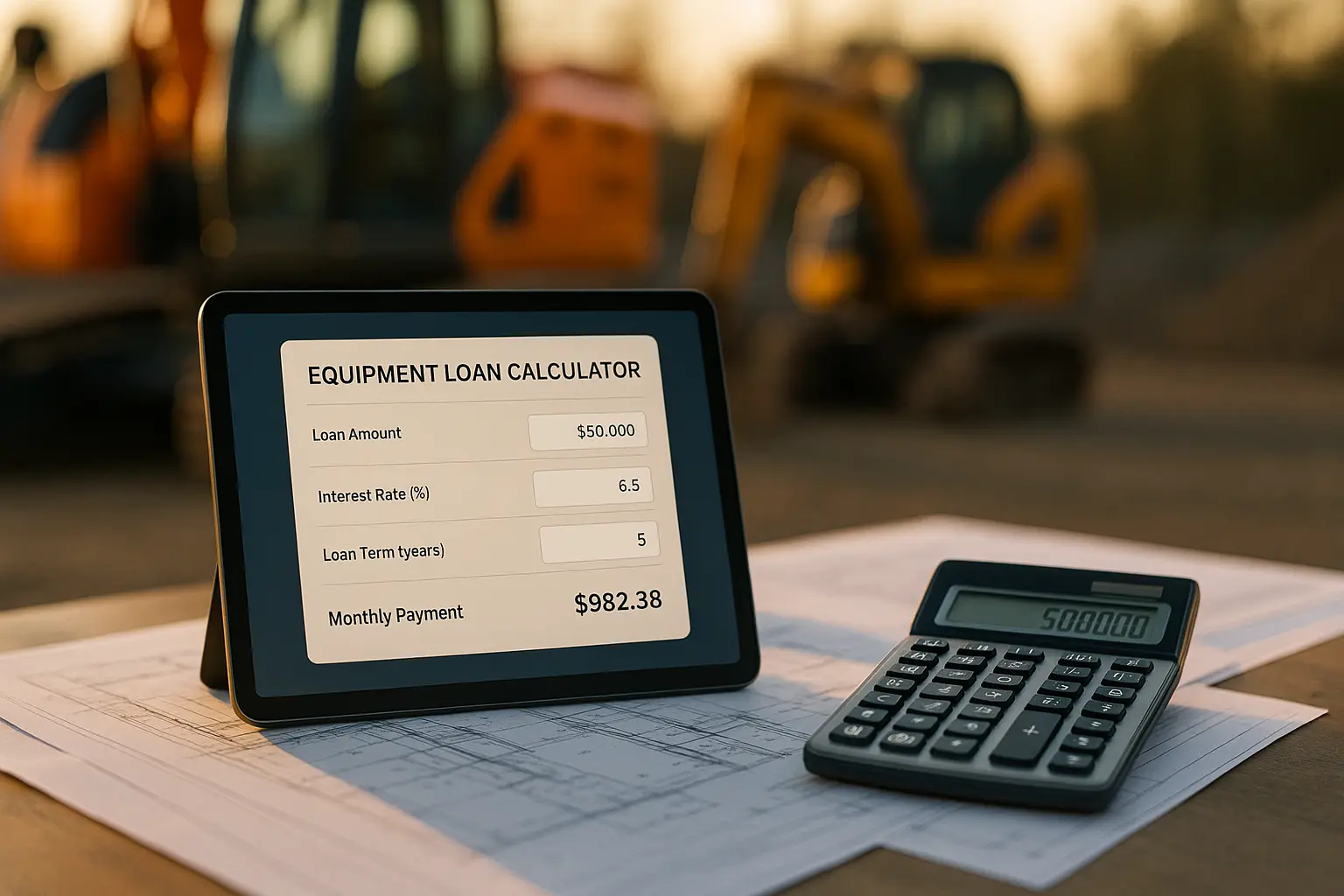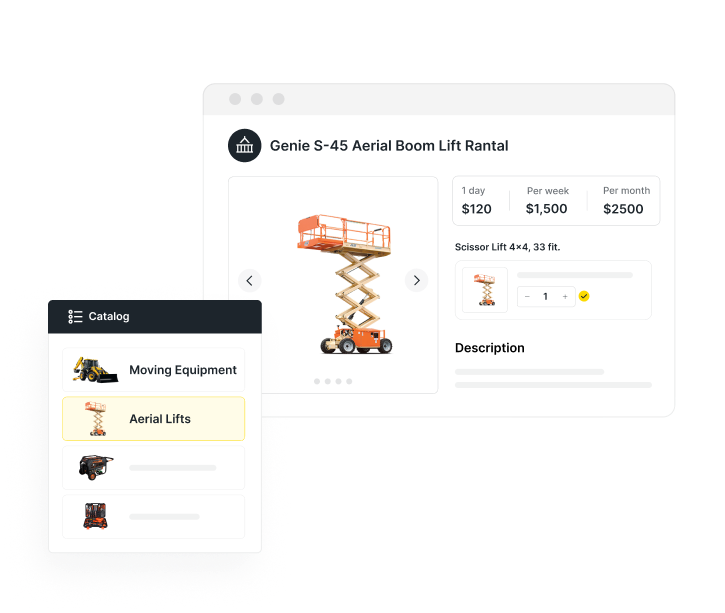Looking to expand your equipment rental fleet? An equipment loan calculator takes the guesswork out of financing decisions, helping you understand exactly what you can afford before you contact lenders.
Construction equipment represents a significant investment, and most rental business owners rely on equipment financing to build and grow their fleets profitably.
Free Equipment & Heavy Equipment Loan Calculator
Use our comprehensive equipment financing calculator below to estimate monthly payments for both standard and heavy equipment purchases. Whether you’re financing a compact utility loader or a heavy excavator, this tool accounts for the key variables that determine your loan terms.
Equipment Loan Calculator
How Equipment Loan Payments Are Usually Determined
Three fundamental factors drive your equipment financing costs:
1. Equipment Loan Total Amount
Your loan amount equals the total equipment cost minus any down payment. For standard construction equipment, loans typically range from $5,000 to $100,000. Heavy equipment financing often starts at $25,000 and can exceed $500,000 for specialized machinery like large excavators or concrete pumps.
Key considerations:
- New equipment generally offers better rates than used equipment
- Equipment with strong resale value may qualify for lower rates
- Some lenders impose minimum loan amounts ($10,000-$25,000)
2. Interest Rates
Equipment financing rates typically range from 2% to 20%, depending on several factors:
- Your credit profile: Personal and business credit scores significantly impact rates
- Equipment type: Heavy equipment often qualifies for lower rates due to better collateral value
- Business financials: Revenue, time in business, and debt-to-income ratios
- Down payment: Larger down payments (15-25%) can reduce interest rates
- Loan term: Shorter terms generally offer lower rates
3. Loan Terms
Equipment financing terms typically span 2-7 years, though heavy equipment may qualify for longer terms up to 10 years due to slower depreciation.
Popular loan term lengths and considerations:
- 24-36 months: Lowest rates, higher payments, minimal depreciation risk
- 48-60 months: Balanced approach for mid-range equipment purchases
- 72-84 months: Lower payments for heavy equipment, higher total interest costs
Many lenders allow early payoff without penalties, though some may charge prepayment fees. Factor these costs against potential interest savings when considering accelerated payments.
Heavy Equipment Cost Calculator
Heavy equipment financing differs from standard equipment loans in several key ways:
Loan Differences:
- Higher loan amounts: Heavy equipment typically requires $50,000+ financing
- Longer terms available: Up to 10 years for equipment over $100,000
- Lower interest rates: Better collateral value often means reduced rates
- Stricter qualification requirements: Lenders require stronger financials for larger loans
Equipment Categories:
- Standard Equipment: Skid steers, compact excavators, forklifts ($5,000-$75,000)
- Heavy Equipment: Large excavators, bulldozers, cranes, concrete pumps ($75,000-$500,000+)
What You Should Know About Equipment Financing
Even the most sophisticated equipment financing calculator cannot account for every lender requirement or special program available.
Minimum Requirements
Most equipment lenders establish baseline qualifications:
Business Requirements:
- Minimum annual revenue: $50,000-$100,000
- Time in business: 6 months to 2 years minimum
- Debt service coverage ratio: 1.25x or higher
Credit Requirements:
- Personal credit score: 600+ (preferred 680+)
- Business credit score: 75+ (if established)
- Clean payment history on existing equipment loans
Financial Requirements:
- Down payment: 10-25% of equipment cost
- Cash flow documentation: Bank statements, tax returns, financial statements
Special Requirements
Beyond standard terms, lenders may offer or require:
Payment Flexibility:
- Seasonal payment schedules for weather-dependent businesses
- Skip payment options during slow periods
- Balloon payments at term end
Additional Considerations:
- Equipment insurance requirements (comprehensive and collision)
- GPS tracking requirements for mobile equipment
- Maintenance agreement requirements for specialized equipment
Examples of Typical Loan Payments for Construction Equipment
Based on current market pricing and our calculator using a 60-month term at 8.5% interest with 15% down payment:
Standard Construction Equipment:
- Skid Steer Loader ($45,000): $747/month
- Compact Excavator ($65,000): $1,077/month
- Backhoe Loader ($85,000): $1,409/month
- Forklift ($35,000): $580/month
Heavy Construction Equipment:
- Track Excavator ($185,000): $3,067/month
- Bulldozer ($275,000): $4,559/month
- Motor Grader ($350,000): $5,803/month
- Concrete Mixer Truck ($265,000): $4,394/month
These calculations assume good credit, established business history, and standard loan terms. Your actual rates and payments may vary.
For comprehensive equipment pricing analysis, review our Construction Equipment Prices guide.
How to Estimate How Much You May Qualify For
Understanding loan qualification helps you shop for equipment within your budget and strengthens your position with lenders.
Revenue-Based Qualification
Most lenders use a debt-service coverage ratio to determine maximum loan amounts:
Calculation Method:
- Annual net income ÷ Total annual debt payments = Debt service coverage ratio
- Most lenders require 1.25x coverage minimum
- Strong businesses (1.5x+ coverage) qualify for better rates and terms
Example:
- Business with $300,000 annual income and $100,000 existing debt payments
- Coverage ratio: 3.0x ($300,000 ÷ $100,000)
- Could potentially qualify for additional $120,000 annual debt service
- Translates to approximately $500,000-$600,000 equipment loan capacity
Business Factors Lenders Evaluate
Financial Strength Indicators:
- Consistent revenue growth over 2-3 years
- Strong gross margins (30%+ for equipment rental businesses)
- Adequate working capital reserves
- Clean tax payment history
Industry Experience:
- Management experience in construction/rental industry
- Understanding of equipment utilization and maintenance
- Demonstrated ability to generate ROI from equipment investments
Collateral Value:
- Equipment type and expected depreciation
- Market demand for specific equipment categories
- Manufacturer reputation and parts availability
Tips to Improve Qualification
Before Applying:
- Pay down existing equipment loans to improve debt ratios
- Organize 3 years of financial statements and tax returns
- Prepare business plan showing equipment ROI projections
- Research equipment values to negotiate from position of knowledge
During Application:
- Work with lenders experienced in your equipment type
- Consider manufacturer financing programs for competitive rates
- Be prepared to provide additional collateral for larger loans
Easily Manage Equipment Rental Accounting
Once you’ve financed new equipment, managing loan payments alongside rental operations becomes critical for profitability tracking and tax optimization.
Quipli’s Financial Management Features
Revenue Optimization Tools:
- Equipment depreciation scheduling aligned with tax requirements
- Real-time profitability analysis by equipment unit
- Equipment utilization reporting to maximize ROI on financed assets
- Preventive maintenance tracking to protect financed equipment value
- Customer payment processing integration for faster cash flow
Financial Reporting: Quipli’s reporting suite provides rental business owners with the insights needed to make smart financing decisions:
- Equipment ROI Analysis: Track revenue performance against loan costs
- Utilization Metrics: Identify underperforming assets that may need remarketing
Expert Insight: “The key to successful equipment financing is understanding your true cost of ownership beyond just the loan payment. Factor in maintenance, insurance, and opportunity costs to make financing decisions that drive long-term profitability.” – Sarah Mitchell, CPA specializing in equipment rental businesses
Breaking Free from Rental Gridlock
Many rental businesses struggle with disconnected systems that make financial management unnecessarily complex. Quipli eliminates operational gridlock by unifying loan management with daily rental operations:
Unified Financial Dashboard:
- Real-time visibility into loan balances, payment schedules, and equipment values
- Integrated customer payments that automatically update cash flow projections
- Maintenance cost tracking to protect financed equipment investments
Scalable Growth Platform: When your rental operation runs on Quipli, adding financed equipment becomes seamless. Our platform automatically incorporates new assets into availability systems, pricing tools, and financial reporting – ensuring your investment starts generating returns immediately.
Ready to finance your next equipment purchase with confidence?
Use our equipment loan calculator above to estimate your monthly payments, then see how Quipli can help you maximize ROI on your investment. Our unified rental platform makes it easy to track equipment performance, manage loan obligations, and scale your business profitably.
Book a personalized demo to see how Quipli transforms equipment financing from a complex burden into a strategic advantage.
Starting your rental business journey? Learn the fundamentals with our How to Start an Equipment Rental Business guide.







